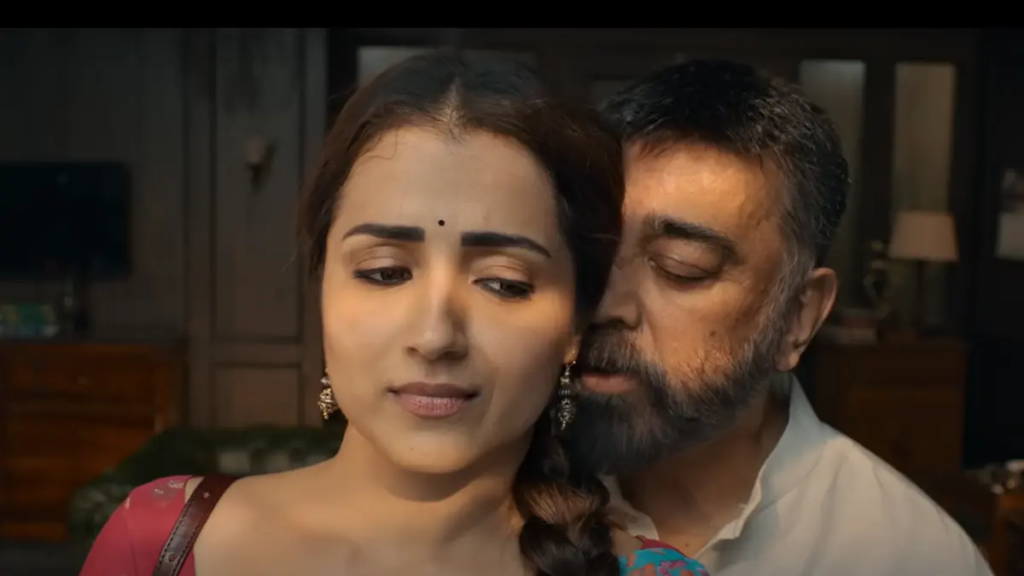Being online has a way of turning observations into accusations, questions into statements, and gestures into slams. One of the first such slams on my timeline, which came after the release of Mani Ratnam’s universally hauled Thug Life, was that Mani Ratnam hates women. How else could he justify a film like this?
Thug Life follows Rangaraya Sakthivel (played by Kamal Haasan), a mafia kingpin in New Delhi, who raises Amaran (Silambarasan T.R.) after he is orphaned, only to be pitted against him in a spiralling, splenetic splat of blood and botched violence. Sakthivel has a wife (Abhirami). He also has a girlfriend (Trisha), a woman he rescued from sex work. One loses her memory. The other dies. Sakthivel mourns both. Here are women whose cinematic presence is entirely justified by their orbit around men. Is it Mani Ratnam? Or is it the genre’s template?
I want to take this slam seriously, not because I think it is true but because it offers pathways to read Mani Ratnam’s films. His is a filmography that has burned bright with a constellation of some of the most vocal, forthright female characters: Divya (Revathi) in Mouna Ragam, Shakti (Shalini) in Alaipaayuthey, Tara (Nithya Menen) in OK Kanmani. Not to speak of the women in his more political films, who bomb themselves (Dil Se), embark on long arduous searches for their kidnapped husband (Roja), or even topple empires (Ponniyin Selvan). They can walk away from a man (Guru, Aayutha Ezhuthu) or mother the man’s child while waiting for him to return (Kaatru Veliyidai) or play second fiddle to the other woman (Iruvar) or the man’s job (Kannathil Muthamittal).
Even when his films have spaces for women away from the male gaze—songs such as Mouna Ragam’s “Oho Megham Vandhadho”, Roja’s “Chinna Chinna Aasai”, and Guru’s “Barso Re”—that gaze folds them into their story anyway. That is to say, Mani Ratnam writes women whose freedom is gestured at but never realised.
Also Read | Chhaava and the mythology of anger
Thug Life, though, belongs to the gangster genre, and the limitations of the genre are the limitations he has replicated not just in this film but also in another gangster saga, Chekka Chivantha Vanam (CCV). The question is not about Mani Ratnam hating women but about Mani Ratnam, a director who has toyed with the possibility of genres, being unwilling to open up the gangster genre to women. It is silly how women are dangled as bait, slipped between men’s palms for the sake of narrative convenience. The more potent question then becomes, does the gangster genre hate women?
What Mani Ratnam does not give his women in terms of narrative space to sketch their characters more fully, he gives them in quick-witted dialogues that demand clarity and have a strange agency. This is the fragile part of Mani Ratnam’s filmography. His women speak so clearly about what they desire that we mistake this outspokenness for subversiveness. To demand your oppression, and revel in it, is not to signal your freedom. Being fiercely vocal about your oppression is not evidence of its absence.
I keep returning to this scene from Mani Ratnam’s Alaipaayuthey, where Shakti wears the thaali, the ceremonial thread of marriage that wives haul around their necks like a symbol, like a noose, but it is a logistical nightmare during sex and so she removes it. That becomes a site for comedy. She still desires it, she says, she loves the thaali as a symbol so much she jokes that it is perhaps more important than him: “Enakku thaali dhaan venum. Nee vendaam, po” (I only want the thaali, I don’t want you, go away).
Mani Ratnam is not interested in the replacement of tradition with modernity but the creation of a traditional modernity. Shakti is, after all, a woman who stepped away from her family to pursue what she desires: this man, this marriage. Is that not agency, even if it is one circumscribed by the demands made by a male world on women? It is first-wave feminism.
It is true that even when he writes women who are violated (rape in Ravanan) or cheated on (the wives in CCV, Thug Life, Iruvar), he never lets the women not have the last word. They know what they want, what they lack. They voice it. We mistake this forthrightness for their progressive zeal, but what they are circumscribed by are still traditional values. Because what they are fighting for is not substantive freedom, in any form, but its erosion. That they are confident in this posture might make us wonder if they might be fighting a different battle than the one they think they are fighting.
Also Read | Payal Kapadia’s All We Imagine as Light creates a new cinematic language
Mani Ratnam’s is not a rejection of tradition but an accommodation within tradition. That is what people get wrong about his movies: those who argue about its modernity and those who argue about its conservativeness. His is the desire to be modern within marriage, not to reject marriage out of a desire for modernism.
And this is why style is so important in his cinema. The way he frames these scenes, the slick, clean moves of the camera, the burned silhouettes, the pungent scores—all gesture at an audio-visual break from the mainstream, only to ultimately belong to that very mainstream. It gestures through style but wends its weary way back home. It hopes for a new aesthetic to be read as a new ethic.
Prathyush Parasuraman is a writer and critic who writes across publications, both print and online.
Source:https://frontline.thehindu.com/columns/mani-ratnam-thug-life-women-cinema/article69709614.ece

